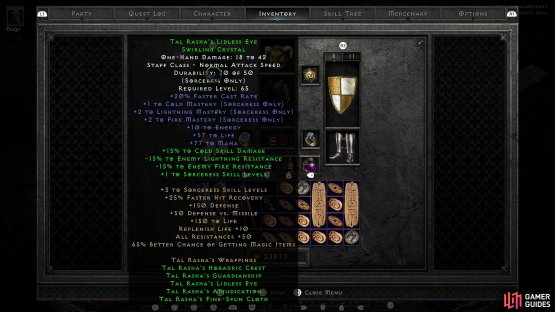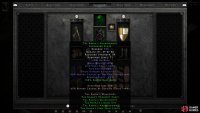Information about set items in Diablo 2: Resurrected, including partial and full set bonuses.
Set items are a class of items that can drop in Diablo 2: Resurrected. They’re more common than unique items, generally, and like unique items have static properties (although some can have variable ranges). What sets set items apart are the bonuses derived from wearing multiple pieces of the same set, which will grant additional bonuses. The number of items required for partial set bonuses varies by set, and some bonuses appear on specific items within a set, while others are unlocked regardless of which specific items you’re wearing. If you complete a set, you’ll get a full set bonus, which is usually considerably greater than the bonuses provided by partial set bonuses.
Set items are easily identifiable due to their green name coloration.
Like unique items, set items are modified versions of normal gear, and an enemy/container must have a sufficient level to drop a specific set item. This can be somewhat confusing, as individual items within a set are under no obligation to be remotely similar in quality, meaning there can be significant level requirement gaps between items within the same set. For example, Immortal King’s Detail War Belt has a required level of 29 and can drop fairly early in the game, while Immortal King’s Soul Cage Sacred Armor has a required level of 76, and won’t drop until late in Hell difficulty. This is mostly due to the relatively rarity and quality of the base items - in the case of the former, an exceptional Plated Belt and in the latter case, elite Ancient Armor. This is not an isolated case, especially not for class-specific sets (sets with boons that overwhelmingly or exclusively benefit only one class over all others, or sets that have items that can only be wielded by a specific class) - there are many sets you’ll be able to find easily enough, but completing some sets can be quite difficult due to outlier items.
While the obvious inclination may be to collect and wear complete sets, this isn’t always the most effective approach, as set items are rarely the best-in-slot items for any build to wear. In fact, even with partial/full set bonuses accounted for, some set items can’t compete with uniques/crafted/rare items. That being the case, a pick-and-choose approach should be used on a case-by-case basis based on the base properties of the set item(s) and the partial set bonuses they gain.
(1 of 2) Full set bonuses for Tal Rasha’s Wrappings.
Full set bonuses for Tal Rasha’s Wrappings. (left), Partial set bonuses on Tal Rasha’s Guardianship. (right)
A good example is Tal Rasha’s Wrappings, which gives the following bonuses for completing the set:
- +3 to Sorceress Skill Levels
- +25% Faster Hit Recovery
- +150 Defense
- +50 Defense vs. Missile
- +150 to Life
- Replenish Life +10
- All Resistances +50
- 65% Better Chance of Getting Magic Items
Not to mention the following partial set bonuses:
Tal Rasha’s Adjudication
- +10% Faster Cast Rate
Tal Rasha’s Fine-Spun Cloth
- +10% Faster Cast Rate
- +60 Defense
Tal Rasha’s Guardianship
- +10% Faster Cast Rate
Tal Rasha’s Lidless Eye
- +15% to Cold Skill Damage
- -15% to Enemy Lightning Resistance
- -15% to Enemy Fire Resistance
- +1 to Sorceress Skill Levels
It’s a collection of significant bonuses, but considering the stats on Tal Rasha’s Lidless Eye and Tal Rasha’s Horadric Crest compared to, say, [The Oculus], Heart of the Oak or Harlequin Crest, it’s pretty obvious that you’d gain better overall benefits from sticking with three Tal Rasha’s set items (Tal Rasha’s Adjudication, Tal Rasha’s Fine-Spun Cloth and Tal Rasha’s Guardianship)
While full sets are a fun concept, they are rarely worn at higher levels of play, although collecting full sets (like Sigon’s Complete Steel) can make subsequent playthroughs with new characters much quicker and easier. For high-level play, sets are either worn piecemeal or not at all.




No Comments